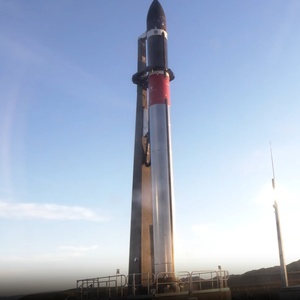The "Baby Come Back" mission includes NASA's Starling project, which consists of four CubeSats designed to test technologies for future swarm missions. Telesat contributes the LEO 3 demonstration satellite, ensuring continuity for customers and ecosystem vendor testing. Additionally, two 3U satellites carrying GNSS-RO payloads from SpinGlobal will replenish their constellation of over 100 multipurpose satellites.
Electron is a two-stage orbital expendable launch vehicle (with an optional third stage) developed by the American aerospace company Rocket Lab. Electron is a small-lift launch vehicle designed to launch small satellites and cubesats to sun-synchronous orbit and low earth orbit. The Electron is the first orbital class rocket to use electric-pump-fed engines, powered by the 9 Rutherford engines on the first stage. It is also used as a suborbital testbed (called HASTE) for hypersonics research.
See Details
Rocket Lab has successfully recovered the Electron booster after a soft parachute splashdown in the Pacific Ocean.
Result: Successful Parachute Landing landing at Pacific Ocean.Rocket Lab is an American aerospace manufacturer with a wholly owned New Zealand subsidiary. The company develops lightweight, cost-effective commercial rocket launch services. The Electron Program was founded on the premise that small payloads such as CubeSats require dedicated small launch vehicles and flexibility not currently offered by traditional rocket systems. Its rocket, the Electron, is a light-weight rocket and is now operating commercially. The company is also producing a variety of spacecrafts and spacecrafts components.
INFO WIKIThe ‘Baby Come Back’ mission successfully lifted off from Launch Complex 1B on the Mahia Peninsula in New Zealand at 01:27 UTC,...
A Rocket Lab Electron rocket placed seven smallsats for three customers into orbit July 17 on a launch that also brought the company a step closer to reusing the rocket’s booster.
The week of July 16 through July 23 will see at least four more launches take place around the world, potentially increasing the orbital launch count to 108 so far in 2023. This includes Rocket Lab’s launch of the “Baby Come Back” mission …
Rocket Lab’s next Electron launch will feature upgrades to the rocket that bring the company a step closer to being able to reuse its first stage.
Rocket Lab is expected to launch seven satellites from Launch Complex 1 on the Mahia Peninsula in New Zealand. This will be...
Gaofen is a series of civilian Earth observation satellites developed and launched for the China High-definition Earth Observation System (CHEOS), a …
A batch of 20 satellites for the Starlink mega-constellation - SpaceX's project for space-based Internet communication system.
3 weather satellites performing atmospheric measurements using GNSS Radio Occultation for a Tianjin based company. Constellation is planned to have a…
Maiden Flight of the Ariane 62 launch vehicle, carrying ten cubesats, two deployers, five experiments, and two reentry capsules.
Türksat 6A is Turkey's first domestically manufactured geostationary communications satellite. It is to reside in 42° East orbital slot, providing se…
A pair of satellites officially described as for cartographic surveying purposes, details TBD.
Fifth flight of the Firefly Alpha small sat launcher, carrying eight cubesats for NASA's ELaNa 43 (Educational Launch of a Nanosatellite) mission.
A batch of 20 satellites for the Starlink mega-constellation - SpaceX's project for space-based Internet communication system.
The Advanced Land Observing Satellite-4 (ALOS-4) is a Japanese satellite designed to observe the Earth's surface using a phased array type L-band syn…
Chinese communication geostationary satellite for unknown purposes.